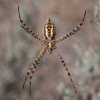- Joined
- Sep 16, 2009
- Messages
- 170
Having moved south I just discovered this species last year and love their size and beauty. Last year had one in my tomatoes and this one is living in my pumpkins. Wish I could keep these, but they build big webs and don't live long anyway. I guess not disturbing them in my garden is kind of like keeping them...
Anyway, the first is a close-up of the female. (Missing leg IV on the right.) The second has the male in the top-left of the shot. He is actually in a smaller, more cobwebby web just behind her big orb. Apparently they will build one to hang around a female sometimes to wait until she is receptive or to mate multiple times. In this case I found him last week in her web. He would twitch the web, wait for a response, skitter a little closer and twitch again. He would keep doing this until he got close enough to scare himself a bit, then run to the edge and start again. Didn't get to see a mating as she was occupied eating a grasshopper, and when I finally went to get a camera he had retreated to his web for the shot. But now I will start watching out for eggs arriving soon!
Anyway, the first is a close-up of the female. (Missing leg IV on the right.) The second has the male in the top-left of the shot. He is actually in a smaller, more cobwebby web just behind her big orb. Apparently they will build one to hang around a female sometimes to wait until she is receptive or to mate multiple times. In this case I found him last week in her web. He would twitch the web, wait for a response, skitter a little closer and twitch again. He would keep doing this until he got close enough to scare himself a bit, then run to the edge and start again. Didn't get to see a mating as she was occupied eating a grasshopper, and when I finally went to get a camera he had retreated to his web for the shot. But now I will start watching out for eggs arriving soon!
Attachments
-
69.4 KB Views: 325
-
120.9 KB Views: 316








